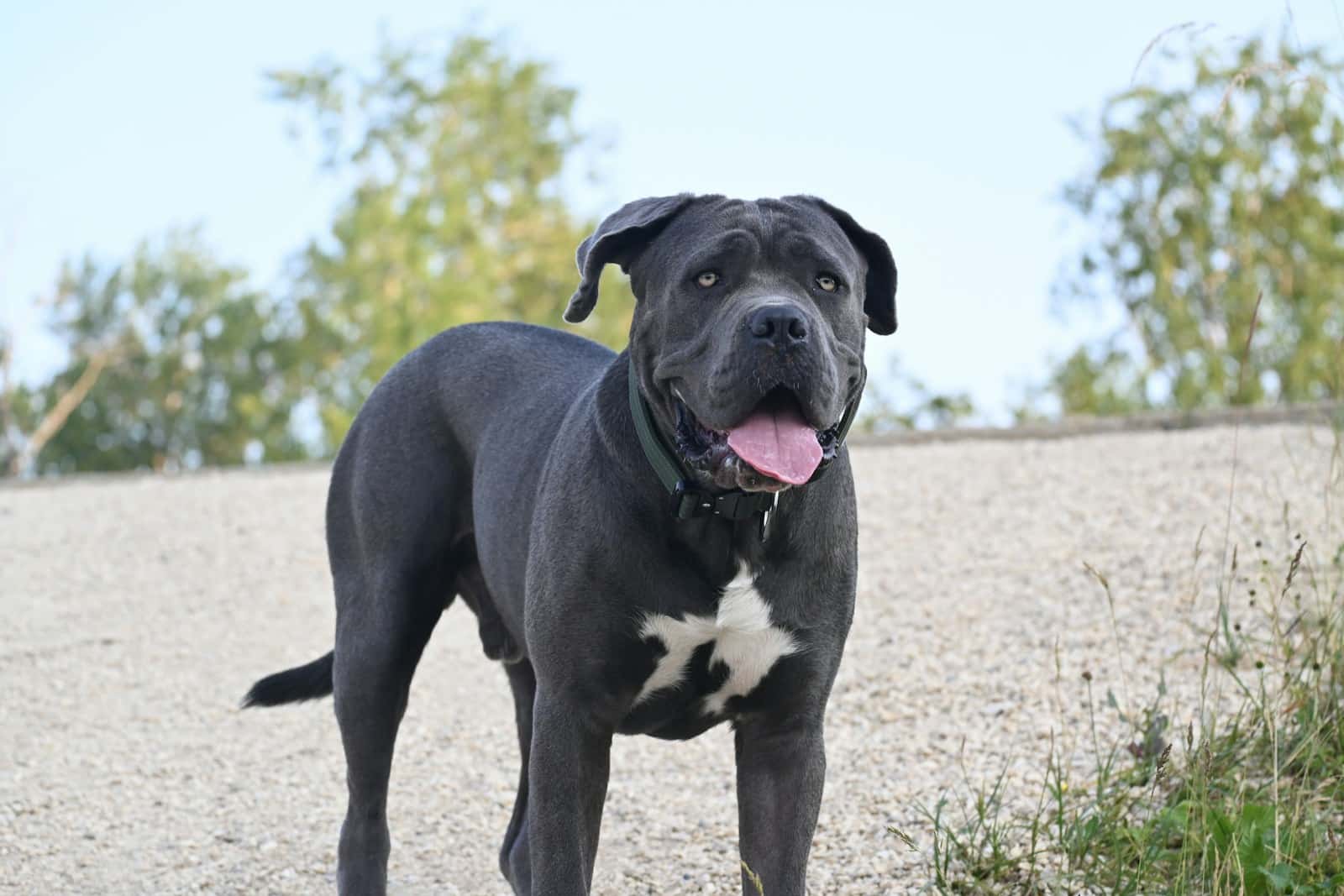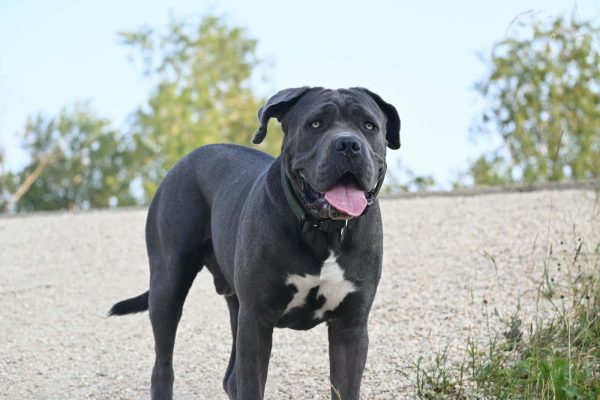Click Below to Skip Ahead
A massive, muscular body draped in heavy curtains of loose-hanging skin is the unmistakable look of an unflinching guardian. The Neapolitan Mastiff is an Italian classic, symbolizing the country’s rich culture as enduring as its ancient art and architecture. With a mellow personality paired with head-turning looks, the gentle canine can grab anyone’s interest. You’ll discover if this is the breed for you as we explore the Neapolitan Mastiff’s care and traits.
Breed Overview
Height:
24–31 inches
Weight:
110–150 pounds
Lifespan:
7–9 years
Colors:
Blue, black, mahogany, tawny, brindle markings
Suitable for:
Low-activity families with older kids, experienced owners
Temperament:
Loyal, dignified, confident, protective, stubborn, sensitive, mild-mannered, aloof
Known as the Mastino Napoletano in its native Naples, the Neapolitan Mastiff descends from Molossians dating to ancient Greece. Roman forces used these fearless, imposing war dogs on the battlefield, in blood sports, and as home protectors. As a close relative of another Italian Molosser breed, the Cane Corso, the Mastino was for centuries a favorite guard dog for everything from palatial estates to rural farms.
While Molossers set the foundation for the various mastiff types we know and love today, each offshoot distinguished itself in form and character. In the Neapolitan Mastiff’s case, the defining features include an enormous head and an abundance of wrinkles.
The droopy appearance was a focal breeding goal in the 1900s, giving us fantastic folds that make modern show dogs easily identifiable. Neapolitan Mastiffs are dripping in skin, with enormous frames that don’t seem big enough to fit their baggy body suits.

Neapolitan Mastiff Characteristics
Neapolitan Mastiff Puppies
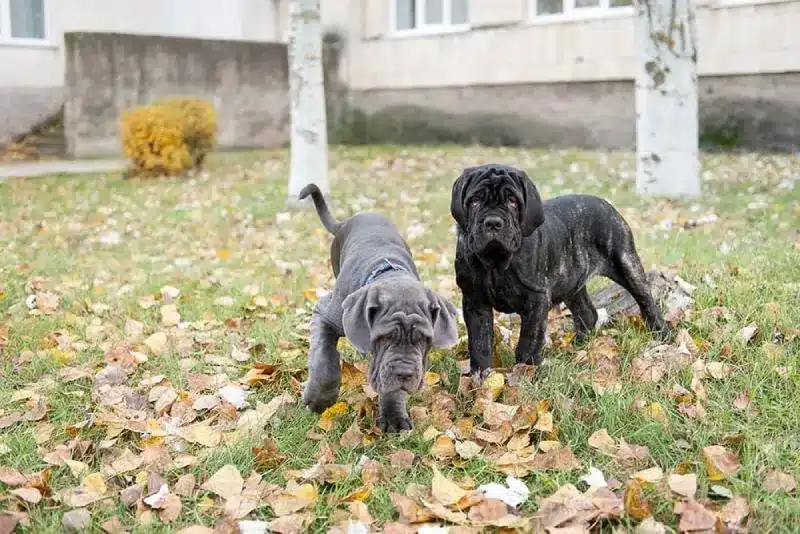
The Neapolitan Mastiff isn’t a particularly popular dog, so breeders are sparse. The AKC Marketplace is a sound starting point that gives you access to AKC-registered breeders nationwide. The United States Neapolitan Mastiff Club likewise shares its list of breeder members. The national club also refers hopeful owners to Mastino Rescue, Inc., a Neapolitan Mastiff rescue group hosting surrenders and rescues of all ages.
Due to the various health issues inherent in the Neapolitan Mastiff, vetting the breeder is vital. They should provide comprehensive testing to rule out common defects and let you see the puppy’s parents.
Ideally, the dogs will have received the appropriate socialization with their mother and littermates and positive interactions with people during their critical development stage. While training and socialization will always be crucial for owners, the dogs must be well-adjusted from the breeder.
Temperament & Intelligence of the Neapolitan Mastiff 🧠
Despite their intimidating appearance, Neapolitan Mastiffs are laid-back, sweet, and sometimes downright lazy. They’re mildly affectionate but love to be with their people, often singling out one family member as their favorite person. Beyond their immediate circle, they’ll usually stay aloof or indifferent to other people and pets, even with proper early socialization.
Neapolitan Mastiffs are also highly protective. If a Neo senses any threat to their family, they will stand in the way, fight without hesitation, and refuse to back down.
While this is an attractive trait for many, it comes with some stubbornness. The Neapolitan Mastiff needs an experienced, devoted, firm, and positive owner. Otherwise, they can be willful and independent and test their owner’s boundaries.
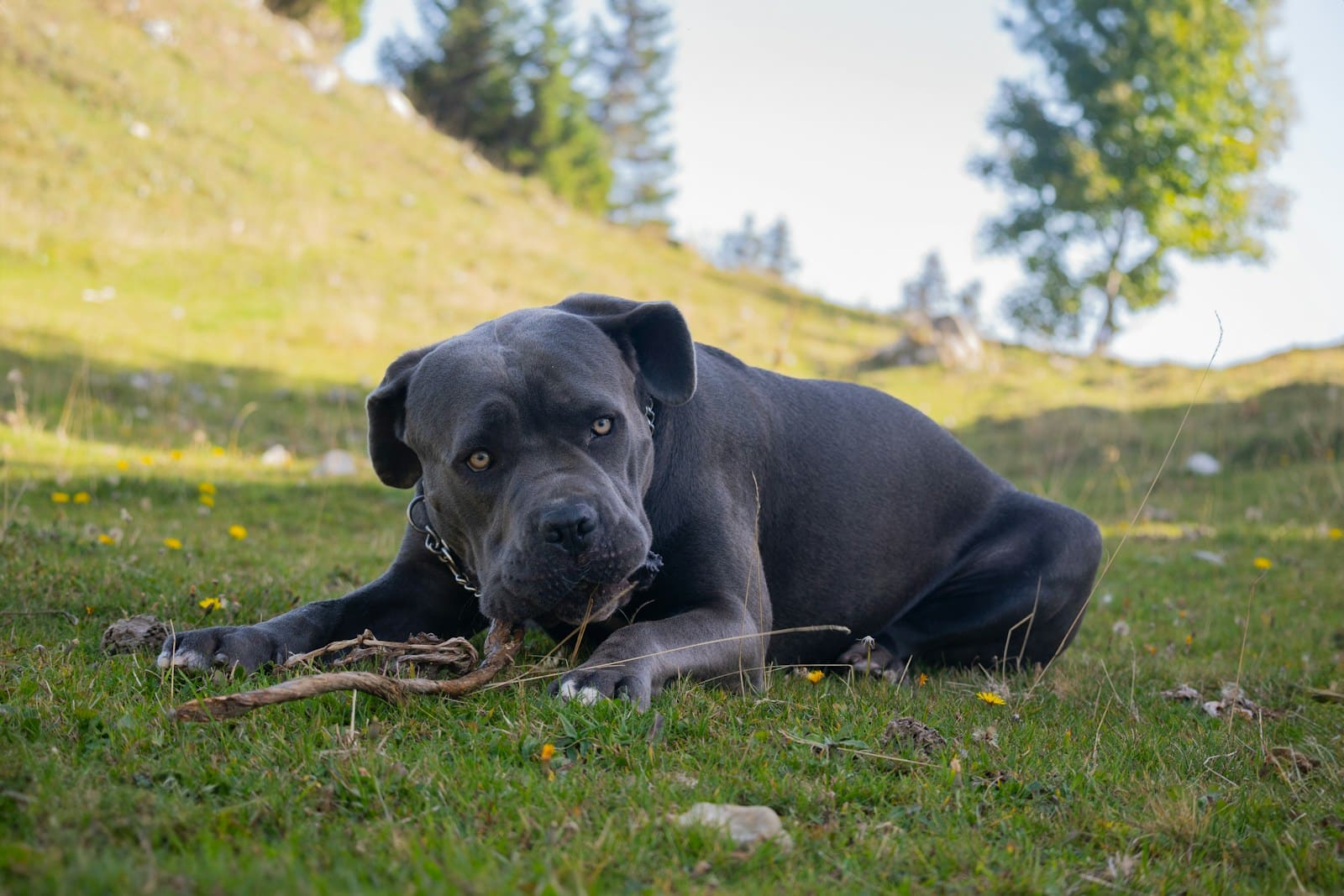
Are These Dogs Good for Families? 🏡
Although they can be a training challenge, Neapolitan Mastiffs are gentle and sensitive pets. They can be playful but mostly stay happy lounging around the house and watching TV with the family. Neos are exceptional guardians for children. But because of their size, these patient and protective pups can still leave the possibility of accidentally hurting a small child.
Training, socialization, and firm leadership are ongoing efforts with Neapolitan Mastiffs. Even the most well-behaved will try your patience on occasion. Otherwise, they’re relaxed and undemanding.
Unlike Border Collies and other high-energy breeds, Neapolitan Mastiffs don’t need constant mental stimulation to stave off boredom and destructive behaviors. Give them adequate daily exercise and enrichment in the house, and they shouldn’t cause many problems when left to their own devices.
Does This Breed Get Along With Other Pets? 🐶 😽
Neapolitan Mastiffs are not known for being tolerant of other pets. They can be dominant and aggressive toward dogs, especially those of the same sex, and their sheer size can immediately threaten others. Although they aren’t highly reactive, they may also chase cats.
As with most breeds, early, frequent, and positive socialization with other animals will help quell these traits. It’s even more critical for the naturally wary Neo. Raising them with another pet from a young age will give them the best chance for an amicable relationship.
Things to Know When Owning a Neapolitan Mastiff:
The Neapolitan Mastiff is a low-energy and relatively low-maintenance dog, but that doesn’t make them easy to own. Though they are trainable and astute, Neos are also independent. It isn’t uncommon for them to ignore a command if it doesn’t suit them.
When given the inclination from an inexperienced and unprepared owner, they can take that disobedience to the extreme by trying to set their own rules and dictate the dynamic. While respect and obedience aren’t always easy to earn, the Neapolitan Mastiff’s love and loyalty are faultless.
They are indoor dogs and want to stick by their owner’s side. In some instances, they may become agitated if someone, including other family members, tries to muscle in on their territory (i.e., you). As an ever-protective presence, the Neapolitan Mastiff demands early and ongoing work to promote their tolerance of others.
Having assorted visitors over to provide positive experiences starting when the dog is young will help them adapt to regular guests and dull their territorial sense. As they’re naturally shrewd, Neos are good at determining who is trustworthy or not with practice. Once they’re mature, they’ll have fewer issues when you have adults or your kids’ friends over for the day.
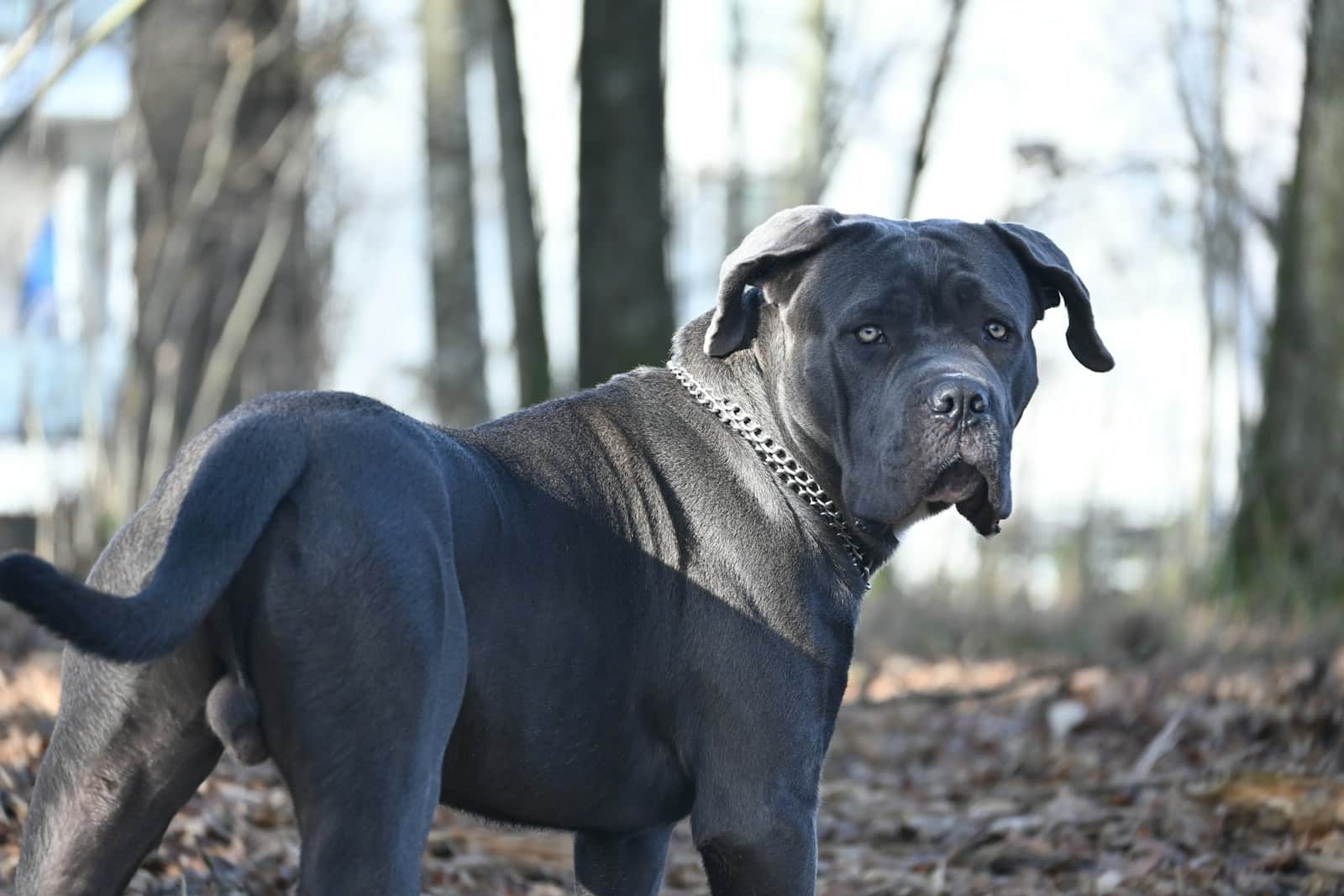
Food & Diet Requirements 🦴
Neapolitan Mastiffs need high-quality large or giant-breed dog food. Since their large-boned and sizeable bodies grow slowly, taking up to 3 years to finish, they need formulas that don’t speed their development.
Large breed formulas are generally lower in calcium and fat to pace their growth and avoid developmental orthopedic disease. Many products include supplements like glucosamine, chondroitin, and omega-3 fatty acids to support and protect their joints.
Once fully grown, a Neapolitan Mastiff will eat about 6–8 cups of dry food daily, though you may want to feed them more than twice. As a giant breed, they are prone to bloat. Feeding them several smaller portions throughout the day can be helpful to prevent any potential problems.
You’ll also want to avoid exercising your dog for about an hour after they eat. Talk to your vet for advice on managing your dog’s diet and feeding schedule as they grow.
Exercise 🐕
Neapolitan Mastiffs don’t need a lot of exercise and will avoid injury with a gentle approach to working out. Walks are sufficient, while jogs, bike rides, and hikes will likely make their heavy bodies too taxing on the joints.
Generally, 30–45 minutes of exercise is adequate as long as you watch for signs of obesity. Beyond exercising, you should also monitor their daily activity around the house for the same reasons, as running up and down stairs or jumping down from a car can overstress their bodies.
Training 🦮
Training is the most critical part of owning a Neapolitan Mastiff and one of the most challenging. Obedience training and exposure to various people, animals, and settings are crucial. If possible, sign up for puppy and obedience classes.
Ensure you enforce strict rules and boundaries at home from a young age. You don’t want to overlook poor behaviors when they’re a puppy that will turn into massive frustrations when they’re hulking adults.
By consistently setting limits from day one, they’ll be less likely to consider unwanted behaviors like jumping on the couch or chewing on clothing. Importantly, you’ll also have to train others to handle your Neo to ensure they receive consistent, productive feedback.
Working on command training will build your bond and establish the household hierarchy. The sessions should be as short as necessary since Neapolitan Mastiffs can quickly tire of training. You don’t want to force training on them but provide it on a predictable routine to maintain control of the process.
Since they are such sensitive dogs, keep sessions positive, avoid harsh punishment, and set your dog up for frequent successes to keep them engaged and eager to please.
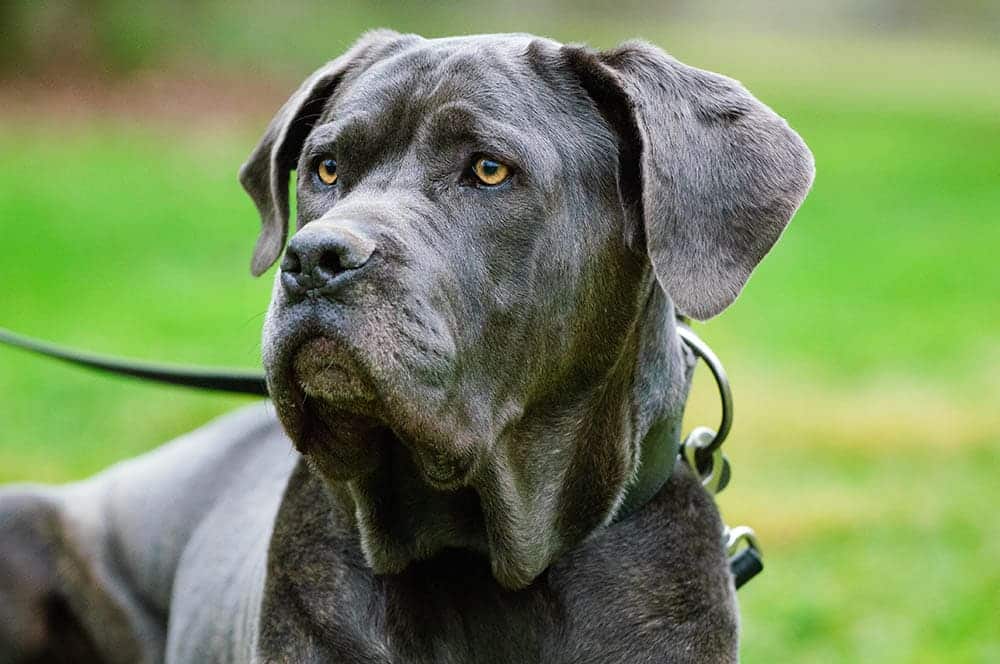
Grooming ✂️
Grooming a Neapolitan Mastiff isn’t challenging and only involves brushing once weekly and bathing them monthly. You can use a slicker brush to remove the shed coat and a rubber brush to stimulate the skin and loosen any dead hair.
The wrinkles add an extra element, as they can trap moisture, dirt, and bacteria that may cause skin irritation and infections. You should wipe down their deep folds with dog wipes every day or two. After bathing, dry the coat thoroughly to remove hidden water in the creases.
As you might suspect, the pendulous jowls make the Neapolitan Mastiff one of the canine kingdom’s biggest droolers. While you can manage it to some extent with good dental hygiene, a healthy diet, and a climate-controlled environment, preventing their drool entirely is practically impossible.
You should always be ready for a quick cleanup. Mealtime creates loads of slobber, but they can unload saliva at any time. Keeping a few towels handy throughout the house will let you react fast.
Health and Conditions ❤️
The Neapolitan Mastiff isn’t the healthiest breed, but their size makes them prone to common Mastiff-type issues, like bloat and elbow dysplasia. Breeding the dogs for their looks has also brought consequences.
The drooping skin that benefits the conformation has the opposite effect on the dog’s body, causing unique health issues. The folds need extra attention to prevent skin problems. Meanwhile, the wilting eyelids make the Neapolitan Mastiff’s deep-set eyes more at risk of worsening problems.
- Eye disorders (e.g., ectropion, entropion, cherry eye)
- Skin allergies
- Dilated cardiomyopathy
- Leishmaniasis
- Gastric dilatation and volvulus (bloat)
- Hip or elbow dysplasia
Male vs Female
Male Neapolitan Mastiffs are notably larger than females. The breed standard has males standing up to 31 inches versus the female’s 29-inch max, with males weighing around 40 pounds more.
Anecdotally, males can be the more aggressive of the sexes. Females are docile and serious. Their upbringing will matter more than their gender in determining the Neapolitan Mastiff’s personality, and desexing can help reduce their intensity.

3 Little-Known Facts About the Neapolitan Mastiff
1. Neapolitan Mastiffs Are Clumsy
Neapolitan Mastiffs are dignified dogs, but you couldn’t accuse them of being the most graceful. The gentle giants are a clumsy breed. Seemingly underestimating their size and strength, they can run into stationary objects, lose their balance, and awkwardly navigate their homes. Though it’s quirky in some ways, this lack of bodily awareness can create a hazard around playful children.
2. Neapolitan Mastiffs Have Enormous Litters
Prepare for a full house if you plan to breed your Neapolitan Mastiffs. Giant breeds tend to have larger litters than most, generally averaging around six to eight puppies. The Neapolitan Mastiff leads the bunch, though, with one dog from the UK holding the current record after having an astonishing 24 puppies in a single litter!
3. Neapolitan Mastiffs Are One of the Ugliest Dog Breeds
All dogs are adorable and endearing in their own way, though looks aren’t always on their side. In the Neapolitan Mastiff’s case, its wrinkled manatee-like face consistently ranks it among the ugliest dog breeds. The mean, droopy mug was a crucial characteristic for it as a guard dog, as one glance at it was enough to deter would-be intruders. Now, the wrinkles some people might call ugly are one of this dog’s most lovable features!
Since the Neo’s revival in the mid-1900s, breeding for more pronounced wrinkles and droopier features has been a focus for many. Neapolitan Mastiffs just kept getting uglier and uglier. Driving the point home, a Neapolitan Mastiff named Martha even took home the title of “World’s Ugliest Dog” in 2017.

Final Thoughts
The laid-back and loyal Neapolitan Mastiff is a perfect match for a mellow lifestyle with enough edge and might to keep you feeling safe. The only question is whether you have the confidence, patience, and experience to earn their obedience. You can’t always expect these famously stubborn dogs to follow your every whim, but when you establish a dynamic of respect, they’ll reward the entire family with endless love and devotion.
Featured Image Credit: Sophie Hollies, Unsplash

